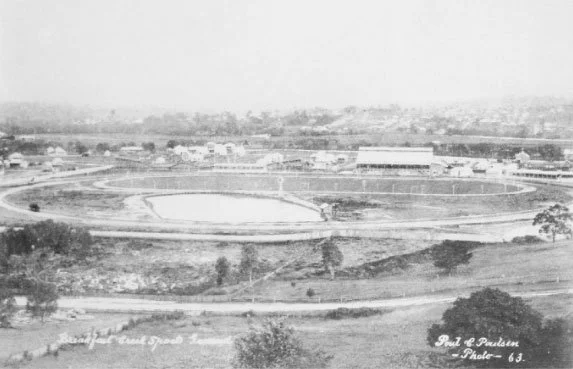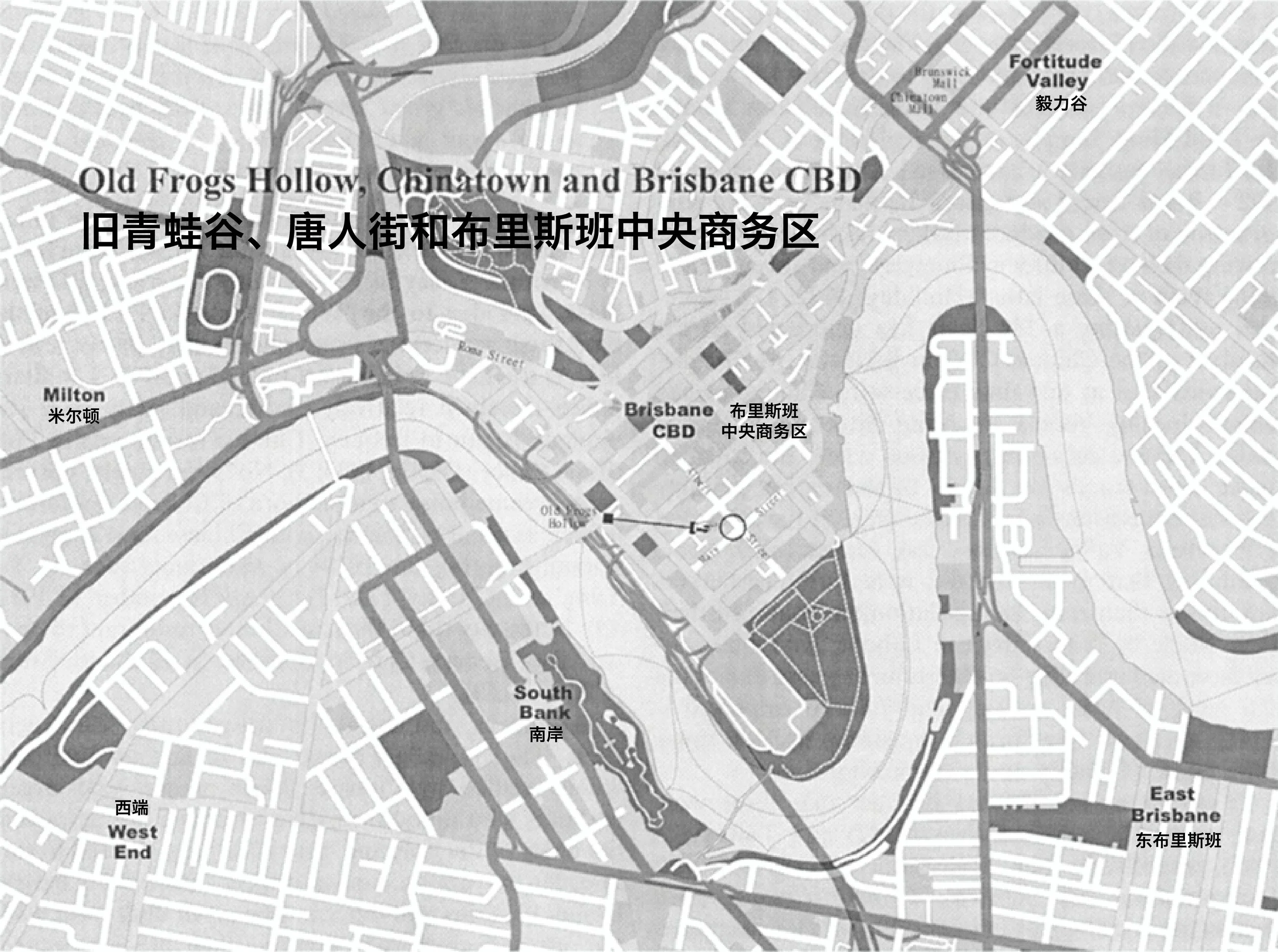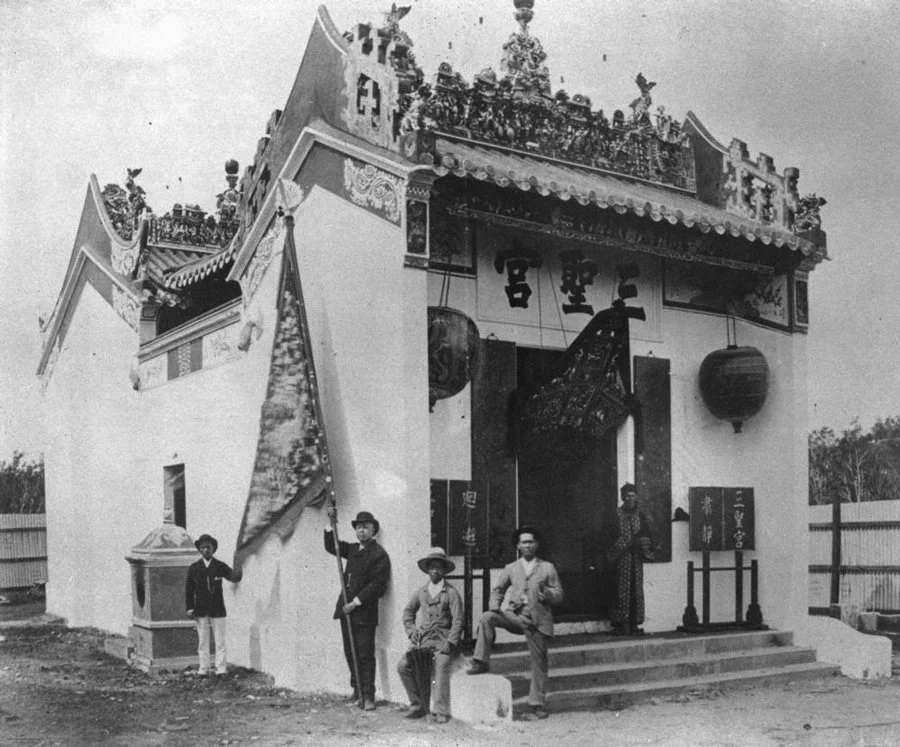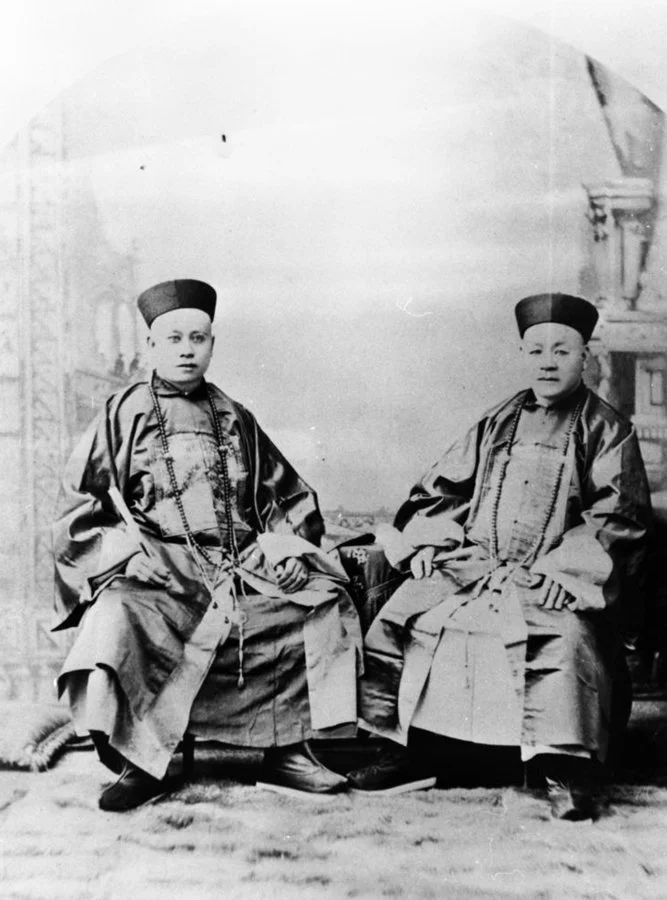Holy Triad Temple 三圣宫
Brisbane was experiencing an unprecedented construction and infrastructure boom during the 1880s, as it evolved from a frontier town into a colonial city. The people were convinced of the unlimited potential of Queensland. This optimism drove prodigal loan spending, inflated land values and an influx of capital from the United Kingdom. This meant that sandstone opulence neighboured homes with flimsy verandas fronted muddy roads. The resident could attend high-class theatre productions, sporting events, and other extravaganzas.
布里斯班在 1880 年代经历了前所未有的建设和基础设施蓬勃期,它正从一个边境城镇演变为一个殖民城市。人们对昆士兰的无限潜力深信不疑。这种乐观情绪推动了挥霍的贷款支出、膨胀的土地价值和来自英国的资本涌入。这意味着富丽堂皇的砂岩建筑带有单薄的阳台和泥泞道路。居民可以出席高级戏剧制作、体育赛事和其他盛会。
1880-1889
Brisbane's 30 years of rapid economic growth which had commenced in 1861 peaked in the 1880s. At the time, Queensland was believed to be a colony possessing unlimited land, resources, and agricultural, pastoral, maritime and commercial potential.
The total population of Greater Brisbane increased from 37,053 in 1881 to 101,544 by 1891. Of this population, 93.7 per cent were of Anglo-Saxon/Celtic origin. The percentages of Brisbane's population of Chinese origin were 0.37 in 1881, 0.55 in 1886, and 0.45 in 1891.
By 1880, gas street lighting was commonplace in the city, and extending to the suburbs. In 1883, electricity was supplied to the Government Printing Office. Electricity had replaced gas for street lighting throughout greater Brisbane by the early 1890s.
Brisbane's suburban railway system expanded to Sandgate in 1882, Oxley in 1883, and Logan in 1885, with Brisbane's Central Station also completed that year. Brisbane's first tram line opened in 1885 running from Victoria Bridge to the Exhibition and Breakfast Creek, within a short walking distance of the Holy Triad Temple construction site.
The horse-drawn tramway system opened with the arrival of nine cars built in New York and nine built in Philadelphia. The highly polished cedar and mahogany cars mounted on steel springs were promoted as making motion almost imperceptible. The cars were drawn by two horses, with a third used for steep gradients. The tram system was seen a new era of rapid development, enabling the colony to keep pace with a 'fast age’.
The 1880s saw one of Brisbane's biggest building booms with the erection of public and private buildings including the Government Printing Office, the Customs House, the first wing of the Treasury Building, and the Alice Street facade of Parliament House, the South Brisbane Town Hall, and the Queensland National Bank. The bank was hailed at the time as one of the finest examples of banking architecture in the world.
St Patrick's Catholic Church in Fortitude Valley, St Paul's Presbyterian Church in Spring Hill and St Andrew's Church of England in South Brisbane, were all constructed during the 1880s.
Victorian opulence in the form of ostentatious construction extended to commercial buildings, city offices and retail stores; to palatial banks, a host of hotels, four and five storey warehouses, imposing insurance offices and theatres.
Brisbane's construction boom continues and was driven by optimism of future continued growth. More sandstone structures with colonnades and balconies fronted on muddy and unpaved roads, and had shops with flimsy veranda posts used for tethering horses for neighbours.
布里斯班的30 年经济快速增长从 1861 年开始,在 1880 年代达到顶峰。当时,昆士兰被认为是一个拥有无限土地、资源以及农业、牧业、海洋和商业潜力的殖民地。
布里斯班的总人口从 1881 年的 37,053 人增加到 1891 年的 101,544 人。在这些人口中,93.7% 是盎格鲁-撒克逊 (Anglo-Saxon )//凯尔特人 (Celtic)。布里斯班的华裔人口的百分比在 1881 年为 0.37,1886 年为 0.55,1891 年为 0.45。
到 1880 年,煤气路灯在市中心已经司空见惯,并且正在扩展到邻近地区。 1883 年,政府印刷局开始有电供应。到 1890 年代初,电力已取代天然气用于整个大布里斯班的街道照明。
布里斯班地区铁路系统于 1882 年扩展至 Sandgate,1883 年扩展至 Oxley,1885 年扩展至 Logan,同年布里斯班的中央车站也竣工。布里斯班的第一条有轨马车线于 1885 年开通,从维多利亚桥开往展览馆和Breakfast Creek,步行不远便可抵达三圣宮建筑工地。
随着纽约制造的九辆车廂和费城制造的九辆车廂的到来,有轨马车线开始运营。安装在钢弹簧上高度抛光的雪松和花木车廂被宣传为几乎察觉不到移动。这些汽车由两匹马牵引,第三匹马用于陡峭的坡度上。有轨马车线被视为开启了一个快速发展的新时代,使该殖民地能够跟上“快时代”的步伐。
1880 年代见证了布里斯班最大的建筑蓬勃期之一,期间建造的公共和私人建筑,包括政府印刷局、海关大楼、库房大楼的第一翼楼、州議会大厦爱丽丝街外墙、南布里斯班市政厅、 和昆士兰国家银行。该银行当时被誉为世界上最好的银行建筑范例之一。
毅力谷的圣帕特里克天主教堂、Spring Hill 的圣保罗长老会教堂和南布里斯班的圣安德鲁英格兰教堂均建于 1880 年代。
华美的维多利亚富裕时代建筑延伸到商业建筑、城市办公室和零售店、 宫殿般的银行、众多酒店、四层和五层高的仓库、气派的保险办公室和剧院。
对未来持续增长的乐观情绪推动了布里斯班的建筑业继续迅速发展。更多带有柱廊和阳台的砂岩建筑面向泥泞和未铺砌的道路,有单薄阳台商店的柱用于为邻里拴马。
References 文献
Crook, DP. 'Aspects of Brisbane Society in the Eighteen-eighties', Honours. The University of Queensland, 1958, p. 50.
Howell, M, R Howell and DW Brown. The Sporting Image: a pictorial history of Queenslanders at play. St Lucia: University of Queensland Press, 1989.
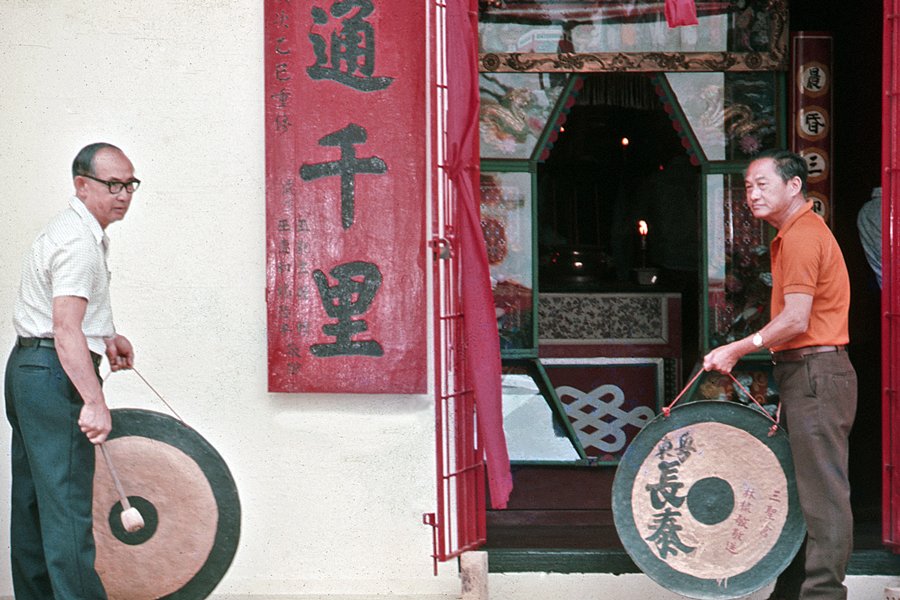

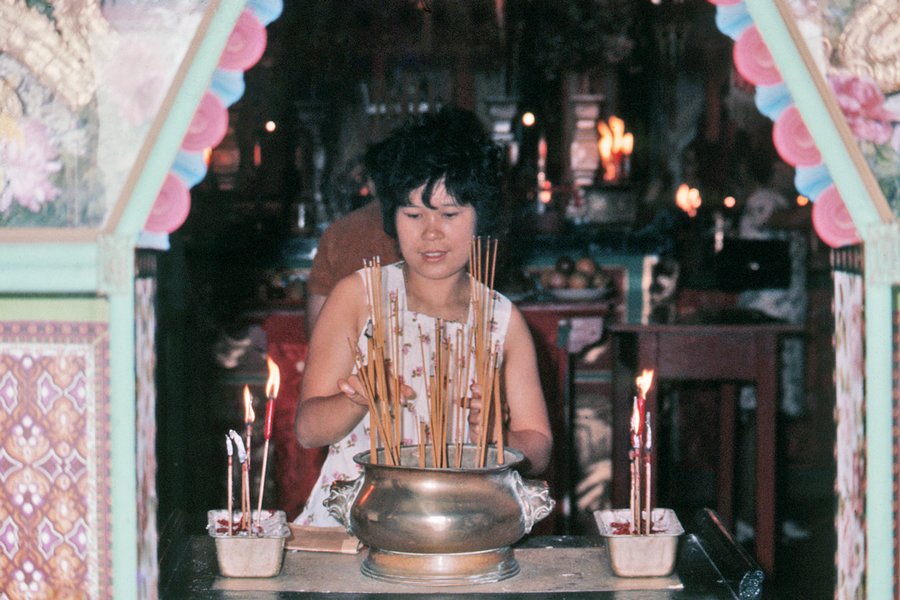
For most of the Chinese people who arrived in the colony through Brisbane during the second half of the 19th century, Brisbane lacked appeal. The city was seen as a transitory stopover on their forward journey.
The first 56 Chinese to come to Brisbane on the Nimrod in 1848 arrived as indentured labourers on five-year contracts for work as shepherds, outback handymen and on the waterfront. Brisbane's Chinese population remained relatively small throughout the remainder of the 19th century, working as furniture makers, domestic servants, market gardeners, hawkers and commercial traders.
During the 1880s, the percentage of Brisbane's population born in China remained close to half of one per cent. These relatively few Chinese settlers in Brisbane were Cantonese from five distinct clan groupings, divided into three groups: the Dongguan, the Zhongshan and the Siyi, being a combination of people from the remaining clans.
Construction of the temple was the vision of financial trustees - Chick Tong, George Shue, Way Hop, Wam Yo and Tong Wah, in an attempt to unite the five clans by providing a common community focus. To achieve this, the Buddhist temple remained open to Confucian Chinese. However, the unification of the clans would take time to be achieved.
An 1892 investigation by Alfred Archey into complaints from Brisbane’s Siyi that they were suffering continuous violent assaults by members of the Dongguan, revealed the extent of clannish divisions in Brisbane’s Chinese population. Archey described the factions as not being friendly to each other. He considered the largest group, the Dongguan, as very treacherous.
Alfred Archey noted that the 300 to 400 Dongguan were led by Fat Kee, Way Ling Loong and Wong Fun. The approximately 200 Zhongshan men's leaders were H. Yeteng of 139 Wickham St, the Valley and the photographer Mr War Sing. The 40 to 50 Siyi were led by Oh Ark, Hing Kee and Ah Foo.
The Dongguan had commenced a subscription fee of £2 and upward for each member in order to pay court fines and legal fees for men prosecuted for these assaults. They had also established a £5 payment for any Dongguan assaulting a Siyi and £20 for breaking limbs. While the Dongguan believed the only penalty for assault would be a fine, they had established a £1 per week retainer for any members who were imprisoned. A further agreement was in place for assaulting any interpreter or witness acting in a case against them.
对于大多数在 19 世纪下半叶通过布里斯班抵达殖民地的中国人来说,布里斯班缺乏吸引力。这座城市被视为他们旅程的短暂停留地。
1848 年,首批 56 名乘坐Nimrod船来到布里斯班的中国人以契约劳工的身份抵达,他们签订了为期五年的牧羊人、远离城镇地区杂工和码头工人的合同。布里斯班的华人人口在 19 世纪余下的时间里仍然相对较少,他们从事家具制造、家庭佣人、园丁、小贩和商人的工作。
在 1880 年代,在中国出生的布里斯班人口比例仍然接近 0.5%。这些在布里斯班定居的相对少数华人来自五个不同籍贯的广东人,他们分为三个群体:东莞、中山和四邑,后者是其余籍贯的組合。
建造寺庙是财务受托人Chick Tong、George Shue、Way Hop、Wam Yo和Tong Wah的愿景,旨在通过提供一个共同的社区焦点来团结五个籍贯群体。为了实现这一目标,佛寺仍然对儒家中国人开放。但是要实现籍贯群体的團結,还需要时间。
1892 年,阿尔弗雷德·阿奇 (Alfred Archey) 对布里斯班四邑人提出的投诉进行了一项调查,即他们不断遭受东莞人的暴力袭击,事件揭示了布里斯班华人籍贯群体分裂的程度。 Archey 将这些派系描述为彼此不友好。他认为作为最大群体的东莞人非常凶险。
Alfred Archey 指出,东莞的 300 至 400 人由 Fat Kee、Way Ling Loong 和 Wong Fun 领导。大约200名中山人领袖是Valley Wickham Street 139号的H. Yeteng和摄影师 War Sing。 40 至 50 四邑人由 Oh Ark、Hing Kee 和 Ah Foo 带领。
东莞人在被起诉时总是被认定为施暴者,甚至在袭击前表明他们的受害者是谁。东莞人不理会警告,落實他们的威胁。
东莞已经开始征收每人 2 英镑及以上,以支付因这些袭击而被起诉的男子的法庭罚款和法律费用。他们还为任何东莞人袭击一名四邑人支付了 5 英镑,打断四肢会支付 20 英镑。东莞人不仅认为袭击的唯一处罚是罚款,他们还为任何被监禁的成员设立每周一英镑的补偿费。他们还达成攻击在案件中对他们不利的任何口译员或证人的进一步协议。
References 文献
Archey, A (testimony). Queensland State Archives. Item ID 86513, Correspondence, Police, 1892
Brandle, M (ed.). Multicultural Queensland 2001. Multicultural Affairs Queensland Community Engagement Division, Department of the Premier and Cabinet, Brisbane, 2001.
Cronin, K. '"The Yellow Agony": Racial attitudes and responses towards the Chinese in Colonial Queensland', in R Evans, K Saunders, K Cronin (eds.), Race relations in colonial Queensland: a history of exclusion, exploitation and extermination, 3rd edn. University of Queensland Press, St Lucia, 1993, p. 237.
Crook, DP. 'Aspects of Brisbane Society in the Eighteen-eighties', Honours. University of Queensland, 1958, p. 50.
Fisher, J. The Brisbane overseas Chinese community 1860s to 1970s: Enigma or conformity, PhD. University of Queensland, 2005, pp. 32-33.
Ip, D. 'Chinese', in M Brandle (ed.), Multicultural Queensland 2001. Multicultural Affairs Queensland Community Engagement Division, Department of the Premier and Cabinet, Brisbane, 2001, pp. 63-65.
Lilley & O'Sullivan. Queensland State Archives. Item ID 86513, Correspondence, Police, 1892.
Queenslander. 30 January 1886, p. 186.
Queensland Figaro. 4 December 1902, p. 3 (7).
Queensland Heritage Register. The Holy Triad Temple ID: 600056, 2013.
Rains, K. 'The Chinese question'. Queensland Historical Atlas, 2010.
Brisbane's Chinese migrants predominantly established businesses in a district known as Old Frog's Hollow at the time, within Brisbane's present-day CBD. These Chinese shops, small businesses and residences were known as the Chinese Quarter. They were mostly on the north side of Albert Street between Charlotte Street and Mary Street, and extended around the corner into Mary Street.
Although the Chinese Quarter was considered unsanitary and renowned for opium and gambling, it was frequented by local and visiting Europeans. Large Chinese retail and manufacturing businesses were also located in George, Queen and Elizabeth Streets in the city, and in Ann and Wickham Streets in the Valley.
Beyond the Chinese Quarter of Old Frog's Hollow, the City centre and the Valley, Chinese migrants had established market gardens as far afield as Ashgrove, Everton Park, Kedron, Eagle Farm, Sandgate, Nudgee, Toowong and especially on the flats around Breakfast Creek and Eagle Farm. By 1888, Brisbane depended almost entirely on these Chinese market gardeners for its supply of fresh vegetables.
The opening of the Holy Triad Temple at Breakfast Creek in 1886 saw it become a popular gathering place for greater Brisbane's Chinese community. Many of the market gardeners chose to bring their wares to the Roma Street Markets via the temple after the completion of a new metal Breakfast Creek bridge in 1889.
布里斯班的中国移民主要在布里斯班现在的市中心一个当时被称为Old Frog's Hollow的地区开展业务。这些华人商店、小企业和住宅被称为华人区。它们大多位于Charlotte Street和Mary Street之间的Albert Street北侧,并在拐角处延伸到Mary Street。
尽管华人区被认为不卫生并且以鸦片和赌博而闻名,但当地人和来访的欧洲人仍然经常来这里。大型中国零售和制造企业也位于该市的George, Queen and Elizabeth Streets,以及Valley的Ann Street 和 Wickham Street。
除了Old Frog's Hollow的华人区、市中心和Valley之外,中国移民在远至 Ashgrove、Everton Park、Kedron、Eagle Farm、Sandgate、Nudgee、Toowong 等地建立了菜园,尤其是在Breakfast Creek和Eagle Farm平地上。到了1888 年,布里斯班几乎完全依赖这些华人菜农供应新鲜蔬菜。
1886 年Breakfast Creek三圣宮的开放使它成为大布里斯班华人社区的热门聚集地。在 1889 年新的Breakfast Creek鉄桥建成后,许多菜农选择经过寺庙将他们的商品带到Roma Street市场。
References 文献
Brandle, M (ed.). Multicultural Queensland 2001. Multicultural Affairs Queensland Community Engagement Division, Department of the Premier and Cabinet, Brisbane, 2001.
Ip, D. 'Chinese', in M Brandle (ed.), Multicultural Queensland 2001. Multicultural Affairs Queensland Community Engagement Division, Department of the Premier and Cabinet, Brisbane, 2001, pp. 65-66.
Queenslander. 12 May 1888, p. 746.
Queensland Heritage Register. The Holy Triad Temple ID: 600056, 2013.
Sum Chick Tong was born in 1849, and died in 1902. Chick Tong married an English woman named Gladys and they resided in the leafy outer suburb of Swan Hill (Kelvin Grove). Chick Tong and Gladys' son, Sun Kum Chee (Shum Chick Tong), was born in Brisbane in 1885, but spent 1890 to 1911 in China receiving a Chinese education. Chick Tong became naturalised 1893.
Chick Tong was Brisbane's pre-eminent Chinese businessman during the 1880s. In 1884, Chick Tong established and controlled Brisbane's most prominent importing and trading firm, Kwong Nam Tai & Co., maintaining two shops in Queen Street, one in Albert Street, and a store in Stanthorpe. The significance of Chick Tong's position in Brisbane society enabled him to play a pivotal role in the planning, approval and construction of the Holy Triad Temple. At its opening, Chick Tong was the leader of the Chinese community and the prime trustee of the temple. However, after 1886, Chick Tong played no further leadership role in the Chinese community.
Through Kwong Nam Tai & Co., Chick Tong was responsible for importing the temple's elaborate roof from China. During the temple's opening ceremony, Chick Tong led the dignitaries with his personal £50 green silk flag, repleted with striking colour and workmanship. The flag represented the Royal Dragon of the Chinese Empire, and was hoisted up a centre flagpole, between the temple's two red flags with white mitred borders.
In 1888, Kwong Nam Tai & Co. was the main target of the 1000 strong mob during Brisbane's race riot. Kwong Nam Tai & Co. was also the only Chinese business protected by the police. By the following year, the lingering effects of the riot had played a pivotal role in the closing of Kwong Nam Tai & Co.
A meeting of Kwong Nam Tai & Co.’s creditors met on Thursday 12 September 1889 to address the company's insolvency. The firm's insolvency was credited to a depression in trade, an inability to collect outstanding debts, interest rates of up to 60 per cent on loan repayments, losses during the 1887 floods, reduction in business due to rising anti-Chinese sentiment after the 1888 riot, and mismanagement of the Stanthorpe store. During the meeting, creditors who had previously felt great sympathy for Chick Tong, and guaranteed his word as unquestionable, came to accuse him of swindling. Chick Tong was accused of lying to his creditors, as his lack of stock contradicted his claims of no sales.
In an example of racial profiling at the time, some consideration was granted that if Chick Tong had been European, he may have been able to give a good explanation for his actions. To this, one creditor demanded an explanation, claiming that Chick Tong was as good as any European in the English language and in accounting. It was suggested that Chick Tong's Jewish money lenders had taken all his stock when he failed to meet repayments. This assumption satisfied the creditors. By the meeting's close, a motion to liquidate rather than go into insolvency was put forward and was unanimously carried.
Sum Chick Tong died on Sunday 30 November 1902, in an ambulance on his way to hospital. It is notable that Queensland's most racist and anti-Chinese newspaper, Queensland Figaro (a weekly newspaper published from 1885 to 1936 in Brisbane), remembered him not only as a Queen Street businessman, but also for being a liberal supporter of the Breakfast Creek Joss House, and for his charity to the poor, when he possessed the means.
Sum Chick Tong 出生于 1849 年,并于 1902 年去世。 Chick Tong 与一位名叫 Gladys 的英国女子结婚,他们住在绿树成荫的 Swan Hill 郊区 (Kelvin Grove)。 Chick Tong 和 Gladys 的儿子 Sun Kum Chee (Shum Chick Tong) 于 1885 年出生于布里斯班,但 1890 至 1911 年在中国接受中文教育。 Chick Tong 于 1893 年入籍。
Chick Tong 是 1880 年代布里斯班杰出的华裔商人。 1884 年,Chick Tong 成立并控制了布里斯班最著名的进口和贸易公司 Kwong Nam Tai & Co.,拥有两家在Queen Street商店,另一家在 Albert Street,一家在 Stanthorpe。 Chick Tong 在布里斯班社会的重要地位,使他在三圣宮的规划、审批和建筑中扮演了举足轻重的角色。开幕时,Chick Tong是华人社区的领袖和寺庙的主要受托人; 然而,在 1886 年之后,Chick Tong 在华人社区中没有发挥进一步的领导作用。
通过 Kwong Nam Tai & Co.,Chick Tong 负责从中国进口寺庙精致的屋顶。在寺庙的开幕仪式上,Chick Tong手持他个人价值 50 英镑,充满醒目色彩和精細做工的绿色丝绸旗帜带领着贵宾。这面旗帜代表中华帝国的御龙,并被悬挂在中央旗杆上,位于寺庙带有白色斜接边框的两面红旗之间。
1888 年,Kwong Nam Tai & Co. 在布里斯班种族骚乱中成为 1000 名暴徒的主要目标。 Kwong Nam Tai & Co. 也是唯一一家受到警方保护的中国企业。到次年,骚乱的挥之不去的影响成为关闭 Kwong Nam Tai & Co. 的主因。
Kwong Nam Tai & Co. 的债权人会议于 1889 年 9 月 12 日星期四召开,以解决公司的资不抵债问题。该公司资不抵债的原因包括贸易萧条、无法收回未偿债务、偿还贷款高达 60%的利率、1887 年洪水期间的损失、1888 年骚乱后反华情绪高涨导致业务减少,以及Stanthorpe商店的管理不善。会上,此前对Chick Tong表示同情,并保证其言行无误的债权人,纷纷指责他诈骗。 Chick Tong 被指控向债权人撒谎,因为他的不足存货与他声称没有销售的说法相矛盾。
在当时一个种族定性的例子中,有人考虑到如果 Chick Tong 是欧洲人,他可能能够对自己的行为给出一个很好的解释。对此,一位债权人要求作出解释,声称 Chick Tong 在英语和会计方面与任何欧洲人一样好。有人认为,Chick Tong 的犹太放债人在他未能偿还债务时已经拿走了他所有的存货。这一假设令债权人满意。会议结束时,提出清盘而不是破产的动议获得一致通过。
Sum Chick Tong 于 1902 年 11 月 30 日星期日在送往医院的救护车上去世。值得注意的是,昆士兰最种族歧视和反华的报章Queensland Figaro (1885 年至 1936 年在布里斯班出版的周报) 不仅记得他是皇后街的商人,而且还记得他是Breakfast Creek寺庙的开明支持者,以及当他有能力时对穷人的善举。
References 文献
Brisbane Courier. 13 September 1889, p. 6.
John Oxley Library, State Library of Queensland. Neg: 10124, 2013.
John Oxley Library, State Library of Queensland. Neg: 150952, 2013.
John Oxley Library, State Library of Queensland. Neg: 197082, 2013.
Queenslander, 30 January 1886, p. 186.
Queensland Figaro. 14 January 1888, p. 76.
Queensland Figaro. 4 December 1902, p. 3 (7).
Queensland Heritage Register. The Holy Triad Temple, ID: 600056, 2013.

